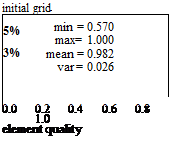Modification of Adapted Grids
The idea of grid modification is to avoid bridging refinements for elements of lower geometrical quality. The borders between different refinement levels are moved into elements of a better quality, see Fig. 11.
 |
 |
Fig. 11 Idea of the grid modification: the initial elements are of various quality (left), the unmodified adaptation leads to bridging elements of even lower quality (middle), moving the bridging refinements to better initial elements avoids the worst elements (right)
The bridging refinements, the so called green elements of the red-green-method, tend to provide children of a lower quality in comparison with the parents and the corresponding children of a regular refinement. So this method can avoid the worst elements of an adapted grid.
To explain the problems of the method, some algorithmic details are needed. An internal edge refinement trial of the TAU adaptation has three main steps. First as much as possible points are (temporarily) removed. In the second step, the initial refinement is done depending on the error indicators of edges and the target size of the grid. Then, points are added iteratively until all elements have a valid subdivision state as a third step.
The only place for the modification is the third step, because in the second step the initial borders between refinement levels are determined. Because a bridging refinement can not taken back in this step it has to be re-refined to a regular one. So additional points are needed for the modification. Furthermore, the regular subdivision of a badly shaped element provides more badly shaped child elements than the bridging subdivision. Therefore, regarding the pure numbers, the portion of badly shaped elements could increase though their quality is not worsened in a modified adaptation.
As a first test the triangles of a two-dimensional grid around a RAE-2822 airfoil are adapted without modification and with a forced regular refinement for all elements with a quality lower than a limit of 0.98, see Fig. 12.
The quality distributions of the adapted grids have much more elements of lower quality than the initial grid. These are the elements of bridging subdivisions. The modified adaptation can avoid the low quality elements of a quality 0.33-0.5 because they come from bridging subdivisions which become regular ones in the modified case. The portion of high quality elements with quality 0.98-1.0 decreases in the modified adapted grid because a lot of them has to be refined nonregularly, taking the borders of various refinement levels in the modified adapted grid. Because of both effects the behaviour of the average quality of all elements after modification cannot be predicted. In this example it is nearly unchanged.
In three-dimensional cases of more complex geometries the element qualities of the initial grids are usually much broader distributed. That is why these effects are overlaying for various qualities. So there are quality slots for which some bridging
Fig. 12 Element quality distribution of a test: initial grid (top), unmodified adapted grid (left), modified adaptation (bottom right), showing the percentage of elements in quality intervals of the length 0.01. The light – grey bars are oversized to the tenfold.

![]()
![]()
 |
 |
adaption (quality limit: 0.98)
elements are avoided by the modification. But some additional elements from regular subdivisions fall into the same slot to avoid elements of even worse quality.
The implemented version of the grid modification requires an input parameter defining the portion of elements which is to be considered for only regular refinement. The TAU adaptation determines the actual quality limit from this portion. In order to have the same behaviour in various adaptation steps, the portion and the limit refer to the initial grid. Furthermore, if an element which is considered for regular refinement has an unrefinable edge, this element is not refined at all.














